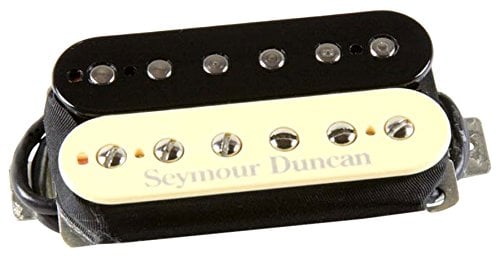Table of Contents
Electric guitars have defined the soundtrack of the modern age. But more than that, they have also sparked a revolution in the world of music. Consider the thick rock riffs you love and the deep, soulful blues music.
The electric guitar has been the driving factor. But have you ever stopped to consider how it actually works? Well, it’s all about the science of electromagnetism.
So, are guitar strings magnetic? The short answer is no, strings themselves are not magnetically charged. The metal strings of an electric guitar interact with the magnetic field produced by the pickups. This creates an electric current that’s then amplified to produce sound.
But there’s a lot more to this magnetic magic. Let’s dive into the world of guitar strings, pickups, and the electrifying science that makes our favorite tunes possible.
Do Guitar Strings Need to be Magnetic?
For electric guitars, yes, the strings need to be slightly magnetic to interact with the electromagnetic pickups. Pickups capture the string vibrations and convert them into an electrical signal for amplification.
But the magnetism is supplied by the pickups, and so guitar strings just need to be made of materials that are ferromagnetic. These are materials like iron and nickel which have a high susceptibility to magnetization.
This magnetic interaction is crucial for the electric guitar’s sound production. However, for acoustic and nylon-string guitars, the strings don’t need to be magnetic in any way.
Their sound production is less dependent on magnetic properties and more on the physical vibrations of the strings and the guitar’s body.
The Science Behind Electric Guitar Strings
When you strum an electric guitar, you’re not just making music; you’re conducting a science experiment. The strings, pickups, and even the air around the guitar come alive with the principles of electromagnetism.
Electromagnetism: The Invisible Force
Electromagnetism is the cornerstone of electric guitar functionality, and it’s deeply rooted in the principles of physics. At its core, electromagnetism revolves around the symbiotic relationship between electric currents and magnetic fields.
According to Faraday’s law of electromagnetic induction, a change in the magnetic environment of a coil of wire induces an electromotive force (EMF) in the wire.
In layman’s terms, when a magnetic field changes around a conductor (like the coil in a guitar’s pickup), it generates an electric current within that conductor.
When you pluck a string on an electric guitar, it vibrates within the magnetic field created by the pickups. This vibration causes a fluctuation in the magnetic field.
Due to Faraday’s law, these fluctuations induce a voltage in the pickup’s coil. This induced voltage, or EMF, is what gets transformed into an electrical signal, which is then sent to an amplifier.
The strength of the induced EMF is directly proportional to the rate of change of the magnetic field, as dictated by Faraday’s equation.
In the context of an electric guitar, the faster or more aggressively you play a string, the greater the change in the magnetic field, leading to a stronger EMF and, consequently, a louder sound.
Guitar Strings: Miniature Dynamos
In a way, the metal strings of an electric guitar act like tiny dynamos. When they vibrate, they disturb the magnetic field created by the pickups beneath them.
This disturbance induces a small electric current in the pickup’s coil. It’s this current that gets amplified and transformed into the sound we hear.

The Role of Pickups
Underneath the strings of an electric guitar lie the pickups, which are essentially magnets wrapped in coils of wire. These magnets create a steady magnetic field that permeates the strings above.
When the strings vibrate, they disrupt this magnetic field, and the pickups detect these disruptions, converting them into electrical signals. An amplifier then boosts this signal, producing the iconic electric guitar sound.
| Component | Function | Science at Play |
|---|---|---|
| Strings | Vibrate to produce sound | Act as dynamos, generating electricity when moved |
| Pickups | Capture string vibrations | Use magnets to create a magnetic field and coils to convert field disturbances into electrical signals |
| Amplifier | Boost the signal from the pickups | Amplifies the weak electrical signal to a level that can drive a speaker |
The Birth of the Pickup
In the early 1930s, George Beauchamp, along with Adolph Rickenbacker, developed the first electric guitar pickup. This invention led to the creation of the Rickenbacker “Frying Pan”. It was the world’s first commercially available electric guitar.
It was a game-changer, setting the stage for the electric guitar revolution. Later, Leo Fender, another pioneer, took the concept of pickups to new heights.
His designs, especially the single-coil pickups in the iconic Fender Stratocaster, became the gold standard for electric guitars.
Types of Pickups
- Single-Coil Pickups: These are the original type of electric guitar pickups. They produce a bright and clear sound, but can sometimes pick up interference from other electronic devices, leading to a characteristic “hum.”
- Humbucking Pickups: Introduced by Gibson in the late 1950s, these pickups are designed with two coils. They “buck the hum” by canceling out the interference that single-coil pickups sometimes experience. The result is a warmer and thicker sound.
The Art of Pickup Placement
The instrument’s tone is highly influenced by the position we find the pickup on the guitar body. And guitars normally have more than one pickup. They are placed at different points along the length of the strings.
By selecting different combinations of pickups, guitarists can achieve a wide range of tones, from bright and twangy to warm and mellow.
Improving the Sound
The electric guitar, in its essence, is a marvel of engineering and design. Yet, achieving that perfect tone is an art, blending both the guitar’s innate characteristics and external enhancements.
Tackling Unwanted Noise
Every guitarist knows the frustration of unwanted noise. Whether it’s the hum from a single-coil pickup or interference from nearby electronic devices, these disturbances can muddy the sound. Some solutions include:
- Shielding: Using conductive materials inside the guitar to reduce electromagnetic interference.
- Grounding: Ensuring all electronic components are properly grounded can significantly reduce noise.
The Guitar Body
While the body of an electric guitar doesn’t resonate like its acoustic counterpart, it’s far from irrelevant. The choice of wood, its shape, and even the finish can influence the guitar’s tonal qualities.
- Wood Type: Hardwoods like mahogany offer a warm tone, while lighter woods like ash or alder tend to be brighter.
- Body Shape: The distribution of mass in a guitar’s body can subtly influence sustain and resonance.
Amplifiers and Effects
The amplifier isn’t just about volume; it’s a tool to shape the guitar’s voice. And when paired with effects pedals, the possibilities are endless.
- Amp Characteristics: Tube amplifiers are known for their warm, organic sound, while solid-state options offer precision and clarity.
- Effects Pedals: From the ethereal reverb to the gritty distortion, effects pedals allow guitarists to craft their own soundscapes.
String Choices
Often overlooked, the type and gauge of guitar strings play a pivotal role in sound quality. Thicker strings can offer more volume and sustain, while lighter sets might provide a brighter tone.
Check out my info packed articles to learn more:

What About Nylon and Acoustic Guitar Strings?
Electric guitar strings are designed with magnetism in mind as we have learned. But nylon and acoustic guitar strings dance to a different tune. Their design and function are influenced by different scientific principles and materials.
Nylon Strings
Nylon strings, such as D’Addario’s Pro Arté, are inherently non-magnetic. Made from nylon, they lack ferromagnetic materials like nickel, iron, or steel.
This means that they don’t interact with magnetic fields in the same way that electric guitar strings do. As a result, they require a different mechanism to amplify their sound.
Acoustic Guitar Strings
Acoustic guitar strings, while not as magnetic as their electric counterparts, do possess some ferromagnetic properties. They’re often coated with phosphor bronze, which is less ferromagnetic than nickel or iron.
This means that while they can interact with magnetic fields, the effect is not as pronounced. Brands like Elixirs produce guitar strings that prioritize acoustic resonance over magnetic interaction.
The primary reason being, acoustic guitars rely on the natural amplification provided by their hollow bodies and sound holes.
Piezoelectricity

Both nylon and acoustic guitars often utilize piezoelectricity to amplify their sound. Unlike the electromagnetic pickups of electric guitars, piezoelectric pickups work by converting pressure or mechanical stress into an electrical signal.
This is achieved using materials like quartz crystals that produce electrical currents when pressure is applied.
In simpler terms, when the strings of a nylon or acoustic guitar vibrate, they exert pressure on a piezoelectric element (often located beneath the bridge). This pressure induces an electrical charge, which can then be amplified.
It’s a fascinating process, quite different from the electromagnetic amplification of electric guitars.
For instance, the KNA’s NG-1 is a piezoelectric pickup that captures the vibrations of nylon strings and converts them into an audio signal suitable for amplification.
Conclusion
The world of guitars is a harmonious blend of art and science. While the magnetic properties of electric guitar strings play a pivotal role in shaping their iconic sound, acoustic and nylon guitars rely on different principles, as you have seen.
It’s this diversity, this blend of science and soul, that makes the guitar such a versatile and beloved instrument.
Whether you’re strumming a chord on an electric guitar or plucking a tune on a nylon-stringed classical, remember that behind every note lies a world of science, history, and passion.
FAQs
Why don’t nylon strings work with standard electric guitar pickups?
Nylon strings are inherently non-magnetic, meaning they don’t interact with the electromagnetic pickups found in standard electric guitars.
Electric guitar pickups rely on the disturbance of a magnetic field by ferromagnetic strings to produce an electrical signal. Since nylon strings don’t disrupt this magnetic field, they don’t produce a signal that can be amplified in the same way metal strings do.
Can I use electric guitar strings on an acoustic?
While electric guitar strings can physically fit on an acoustic, they may not produce the desired sound. Electric guitar strings are designed to interact with magnetic pickups. They might not resonate as well in the hollow body of an acoustic guitar.
Acoustic strings, typically made of phosphor-bronze or bronze, are crafted to produce a richer and louder resonance suitable for acoustic amplification.
How do electric guitars produce sound without a hollow body?
Electric guitars primarily rely on their strings’ interaction with electromagnetic pickups to produce sound. When the metal strings vibrate, they disturb the magnetic field created by the pickups.
This disturbance is converted into an electrical signal, which is then sent to an amplifier. The amplifier boosts this signal, producing the sound we hear.
The solid body of the electric guitar supports the strings and electronics. But it doesn’t play as significant a role in sound amplification as the hollow body of an acoustic guitar.

